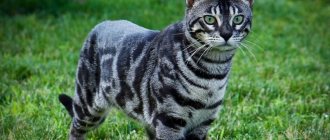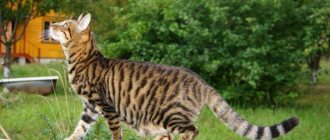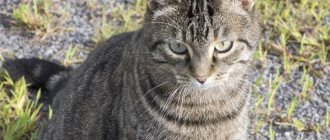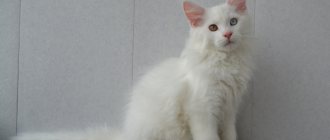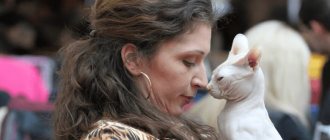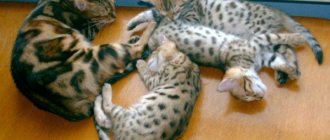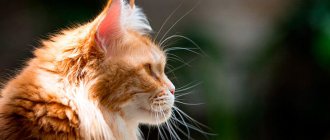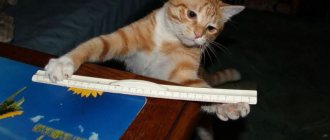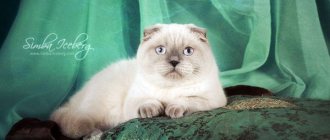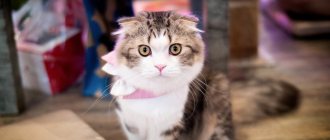Origin of brindle cat breeds
The cat family belongs to a group of mammals from the order Carnivora; they live all over the world. Domestication and artificial breeding of new breeds pleases us with the presence of a pet with an unusual color at home. A prerequisite is dark stripes and spots reminiscent of the coloring of a tiger, leopard or jaguar. Color - from yellow and sandy to dark brown. The body structure is reminiscent of predatory species of wild cats - a long tail, small paws, a head with a wide nose and a thin elongated body with a powerful neck. Miniature tiger.
Purebred breeds of brindle cats are bred only in official nurseries. On average, an adult weighs from 6 to 9 kg.
By the way, our domestic Siberian cat with thick fur that hides the true pattern is directly related to tiger cats. The weight of an adult pet reaches 12 kg. Very loyal to its owner.
How do you get brindle coat color?
Brindle or tabby mackerel is a subspecies of the tabby color. Cats with this pattern resemble miniature tigers. This color is a variation of the colors of cats found in the wild.
Many domestic cats have a ticking pattern called tabby. Ticking appears as a consequence of the dominance of the agouti gene. Each hair has light and dark stripes. Full pigmentation of hair that is in the growth phase is also possible. Then pigment synthesis slows down and resumes after some time. When the hair reaches its full length, pigment synthesis is complete. As a result, the hairs have dark pigmentation at the tips, then there is a yellow or orange stripe, followed by a dark area, and again yellow or orange. It turns out to be a kind of “striped flight”.
Interestingly, genetically the brown tabby is a black color, but as a result of selecting individuals with a pronounced red color, it was possible to obtain a dense brown tone in the ticked hairs.
The tabby color is determined by the gene (T), which causes the appearance of spots and stripes of the main tone on the ticked coat.
Commonly known tabby types:
- Tiger tabby - striped hairs are located on the main background (like a tiger).
- Classic tabby - ticked hairs appear in patches on the sides or back.
- Ticked Tabby (Agouti or Abyssinian) - The ticked hairs are evenly spaced and give the coat a freckled appearance.
- Spotted Tabby - The main background has ticked hair, spots or rosettes (like a leopard or jaguar).
The spotted tabby is not classified as a separate genotype. Scientists have not yet figured out the nature of the origin of the spotted tabby. Whether it can be considered a mutation of the tabby gene or is it just a polygenetic modification of the brindle tabby is not yet clear. Spotted tabby is observed in different species of wild cats and indicates an independent gene mutation. However, in practice, the spotted tabby produces offspring with spotted and striped patterns, so breeders always choose sires with clear spots, otherwise the pattern tends to shift to brindle.
Tortoiseshell cats also have a tabby pattern. In a tortoiseshell tabby, the pattern appears in the black and red areas. Solid and ticked stripes on a red background fade smoothly into black areas.
Savannah
A relatively new breed that was recognized by the Cat Fanciers' Association in 2012, the Savannah is known for its unusual appearance. Large, tall ears are located on the top of the head. The savanna is also characterized by a long neck, long legs and a short, thick tail. In addition, these cats have exotic spotted and striped coats. And this is not surprising, the wild appearance of the savannah was achieved by crossing the African serval with a domestic cat.
Description and features of the wild tiger cat
Oncilla is a tiger cat that lives in the wild. It is much larger than a domestic cat, but the smallest among other wild cats. Oncillas most often have yellow-gray fur with tiger stripes. These cats are not afraid of water and swim well, although not so often.
The wild tiger cat (oncilla) resembles a miniature jaguar. Its coat is short and has characteristic stripes. These stripes on the body consist of individual spots closed in rings.
They clearly go in rows and do not break into separate spots. The stripes on the tail at first simply follow lines of spots, and then these lines connect to the end of the tail, forming rings.
Pictured is a tiger cat Oncilla
Oncilla has several subspecies that differ slightly in color. It is quite rare, although it lives in many places. In the last century, it was hunted for its valuable fur. Its population decreases every year due to deforestation.
The Australian tiger cat is quite unpretentious. It feeds on various small animals and sometimes attacks domestic chickens. In her pouch she carries newborn cubs, of which there can be more than ten.
Asian tabby
The brindle pattern is found among both short-haired and long-haired felines.
The Asian tabby cat is an animal with an exotic tiger color. The color of the coat can reach gray and silver shades, not at all reminiscent of its predatory counterpart. The formation of kittens' coloration can take from several weeks to two to three months. Purchasing an expensive friend is only possible at a specialized breeding farm upon pre-order.
The cost of a pet depends on the pedigree history, color contrast and characteristic pattern. Belonging to a certain class determines the final price. Pet class with differences from the standard color is estimated at 15-30 thousand rubles, Brit class with minimal errors in the standard - from 30-40 without the right and up to 60-70 thousand with the right to further breeding. Show class is a brindle cat with an ideal pattern and the right to breed. It costs from 80 thousand.
Purchasing a kitten
There is currently a toyger nursery in Russia. A small number of nurseries are engaged in breeding mini-tigers. There are no more than three or four of them throughout the country.
How much an animal costs depends on the purpose of its acquisition. Toyger kittens are quite expensive, about 1-2 thousand dollars. The price increases to 4 thousand dollars if the kitten is purchased for breeding, exhibitions and participation in competitions.
True toygers are kittens whose parents do not have other breeds in their pedigree. The author of the breed himself introduced a ban on crossing cats of this breed with others. This is explained by the desire to achieve maximum similarity with tigers.
Toyger. Description
An elite of cats, ideally similar to the powerful "big brother". The name comes from the word "tiger". The Toyger breed was developed by selective breeding by mating a Bengal cat and an outbred Indian cat. It has the perfect transverse stripes characteristic of tiger skin. Representatives of the breed have the muscular build of a wild cat and weigh up to 7–8 kg, while cats weigh up to 5 kg. The animals have a wide chest and strong legs, perfect color contrast.
Reproduction in nurseries of this breed is strictly controlled by the owner. The toyger was officially recognized in 2007; the animals are considered rare and valuable. You can buy a kitten for a price of 1 to 2 thousand dollars (approximately 65-130 thousand rubles) depending on the color received at birth. Catteries sell pre-sterilized felines for home keeping. Selection work to breed the ideal miniature domestic tiger continues.
Features of castration and sterilization
Russian cat breeds: names of the most popular
Castration and sterilization of tiger cats is carried out in the same way as similar procedures for representatives of other breeds.
Males are castrated at the age of 6 months to a year, cats are spayed later - from 10 to 14 months. It is possible to perform the procedure at other times, but this should be discussed with a veterinarian on a case-by-case basis.
After surgery, it is worth taking care of the cats by organizing a place for them where they can calmly recover from anesthesia. It should be warm, with soft bedding. There should definitely be bowls of food and water nearby.
You should not disturb the animal during this period, but you need to keep an eye on them regularly, since severe vomiting is likely after anesthesia.
What to feed?
Tabby cats cannot stand monotony in their food. You cannot feed such a cat with dry food alone. You need to regularly change the type of meat, alternating, for example, chicken with beef and fish. Otherwise, the owner risks throwing the cat's lunch in the trash and being left alone with a hungry predator.
The diet must include fresh meat, live food, mineral and vitamin supplements.
The issue of nutrition is fundamental in keeping animals. The diet should be selected depending on the breed, taking into account the advice of experts.
- The toyger has good health and experts do not give any special recommendations for feeding it. It is sometimes recommended to offer solid food to prevent dental disease.
- Bengal cats also have good health, their life expectancy is up to 15 years. Such expensive animals, as a rule, are fed either high-quality natural products - fish, meat, or expensive cat food with vitamins.
- Tender Sokoke are advised to be kept on a balanced diet with vitamin E and taurine, as their heart and metabolism may be weak.
- Mau often suffer from allergies, asthma and heart problems, so they especially need special food for this breed. If your cat has a tendency to these ailments, be sure to feed your pet correctly.
- Posh Ashers are recommended to be given natural products - high-quality beef, poultry, ocean fish, and leave dry food as an additive to the rest of the diet.
- American Shorthair cats love to eat, so that this does not lead to problems, it is recommended to feed them twice a day, and not on demand. Don’t forget to occasionally pamper them with dietary boiled meat, they love it very much.
- If you take up keeping munchkins, then depending on their age, experts advise feeding them 2 to 5 times a day: kittens - more often, and older animals - less often. Babies who are only a few months old are advised to give cereals, dairy products, meat, while adults can be switched to regular food, wet or dry.
- Siberian cats can be very large, and it is important to correctly calculate the amount of food. Typically, 30-60 grams of feed are given per 1 kg of weight. To make the coat look beautiful and shiny, up to 3 years of age, a diet containing 70% protein is recommended.
Character
The character of brindle cats is as varied as their color, but common features can still be identified. As a rule, these cats are smart, active, cheerful, independent, inquisitive, and easily adapt to new conditions.
They are playful and curious, they like to explore everything around them. Tiger cats are mysterious and graceful, sometimes they prefer solitude, and sometimes they follow their owner’s heels like faithful dogs.
Tiger barbels are funny, emotional, but at the same time capricious. Each of them is devoted to its owner and goes with him through life. Many owners woke them up every day in the morning and met them from work.
They know how to adapt to the owner’s routine, if he is really dear to them, but at the same time they require him to be attentive to himself.
If we are talking about a wild “tiger cat” (for example, an oncilla), then behind its completely harmless and charming appearance hides a dangerous predator. This animal is cruel to its victims and, when hungry, does not leave them any chance of salvation. True, this animal does not show aggression towards humans, trying to avoid him.
Sokoke. Description of the breed and its representatives
Medium sized Sokoke cat with marbled tabby pattern on a sandy background. The ears are large with tassels. The slanted look gives an original expression to the face of the graceful representative of the Kenyan forests. Sokoke is the forest African ancestor of Asian cats. The breed was registered in 1993. A distinctive feature of the tiger cat's coloring is the presence of a necklace around its neck. The color of the skin, similar to the bark of a tree, makes it distinguishable from other subspecies.
A miniature copy of a cheetah has a restless character and irrepressible energy. Strong attachment to the owners and playfulness will make the pet unhappy if its owners are constantly absent or busy with work. Sokoke is ready to play around the clock, which is suitable for families with small children. Hide and seek, chasing and constant movement around the apartment are what an active animal needs. African origin makes itself felt with the onset of cold weather, which is difficult for this heat-loving breed to tolerate.
Types of tabby patterns
There is a classification of tabby patterns, which includes 4 main types: ticked, striped, classic and spotted. They are also called Abyssinian, mackerel, marbled and leopard, respectively.
Table 1. Tabby color types
| Color name | Ring pattern on neck and tail | Drawings on the torso |
| Ticked | Almost invisible, not pronounced in all breeds. The tip of the tail is predominantly dark | The presence of so-called “freckles”, also faintly expressed |
| Striped | Narrow frequent stripes | Thin stripes, often repeated throughout the body, as well as along the vertebral ridge |
| Classical | Large, not always clearly defined | Wide, uneven stripes with curves, spots, and intermittent areas |
| Spotted | Wide, not very visible, interrupted, open | Spots of varying sizes creating the appearance of broken lines |
Ticked
The most subtle and inconspicuous of all tabby colors. At first glance, it seems that such cats are monochromatic - the pattern is clearly expressed only on the face, paws and tail, but the color of their coat is not uniform. There are light stripes, spots or “freckles” throughout the body, which differ from the main color by only a few tones. Mostly representatives of the Abyssinian breed have a similar color, which is why the ticked color received such a second name.
Ticked is the most inconspicuous of all tabby colors.
Striped
The brindle or mackerel color is characterized by the presence of bright narrow stripes, often repeated throughout the body. This type received its second name due to a certain similarity with the color of mackerel - striped fish. The pattern is clearly defined, often starting at the ridge line, going down to the belly in numerous branches. The color of the stripes clearly contrasts with the main color of the coat.
The mackerel color is clearly visible on the cat's fur.
Classical
Marble pattern is considered one of the most beautiful. Wide linear, spiral or graphic patterns have indistinct outlines on the neck and paws, becoming more pronounced on the back and sides of the animal. The body is often decorated with large spots, curls, uneven patterns, designs reminiscent of human eyes, butterfly wings, and oyster valves. The color of the patterns clearly contrasts with the main tone of the coat, which can be any shade except white.
Marbled Tabby
Spotted
The stripes of spotted cats are practically absent and are intermittent and short. The patterns predominantly consist of successive dots, spots and blots. The color of the patterns is bright, slightly or very different in tone from the main color of the coat. Representatives of this type resemble small leopards.
Spotted tabby color
Rarer variants
Although most tabby cats fall under the above classification, there are many exceptions that do not fit into this classification. In the variety of designs and shapes, one can highlight examples of rare beautiful types:
- rosette Looks like leopard print. The spots are larger, have a clear edge of a darker color in the form of an uneven outline and a lighter center. Both tones are usually different from the base coat color;
- tortoiseshell. The uniqueness of the tortoiseshell tabby is that the main color of the animal is two-color (black and yellow shades, as a rule). The drawing does not have a clear order and is not expressed too clearly;
- calico. A third primary color is added - white (on the paws, chest, tail or muzzle, as a rule). The pattern looks more like spots or short thin stripes. Because of this, the second name for the color is spotted with white;
- patched Combines the characteristics of the two previous subspecies. A cat can be both tri-colored and white and spotted, with very large spots alternating with each other like patches. In each individual spot, both the main color and the color of the pattern change. The color is found predominantly in cats;
- links point. The cat seems to have accents from the drawing. Moreover, only some details are painted (muzzle or ears, tail, paws, chest or spine line).
Pixie bob
To develop a breed of cat that resembles a lynx, breeders used short-tailed forest cats. These animals live in the forests of North America. The first cat obtained in this way was named Pixie, which means “Elf” or “Fairy” in English.
The animals are distinguished by a short tail, tufts on the ears and whiskers are possible. Pixies are unpretentious, train well and easily make contact with people.
Bengal and Egyptian Mau
The Bengal breed was the result of artificial mating of a wild leopard cat with outbred Californian cats in 1963. The breed was registered in 1983 and is more common than the Toyger.
Egyptian Mau are spectacular cats with short hair and slender legs, with the grace of a queen and large eyes. The four subspecies include smoke and silver with black spots, honey and sand with brown leopard patterns.
When a sacred pet died in ancient Egypt, it was buried with honors in the family crypt or in a separate animal cemetery. The embalmed feline was accompanied to another world by mummified mice.
What kind of breed, how did it come about?
Tiger cats (lat. Leopardus) are a genus of the cat family, a group of carnivores.
The Latin name of the genus has nothing to do with leopards; tiger cats are classified as a subfamily of small cats. They are distinguished by gray or yellowish-brown fur, which necessarily has patterns in the form of stripes or black spots. All representatives of this genus live in the New World, most of all in Central and South America.
The tiger genus dates back a very long time. These were wild cats that lived in different parts of the world. And today some representatives of the genus remain among the wild. But there are varieties created artificially.
British and American breeds
The brindle color of the British cat attracts many breeders. Representatives of this breed have an obstinate character and the appearance of a fabulous Cheshire cat. The animal requires a lot of free space for constant movement and a separate place for privacy. The purchase price at the nursery is about 10 thousand rubles.
The American Shorthair is an active and strong cat, ready to jump and play all day long. Tiger stripes can be any color. Long-lived among domestic cat species.
Features of choosing kittens of brindle breeds
Tiger cats are expensive, sometimes you have to queue for them, especially for those who want to get a purebred animal. It is worth purchasing representatives of the breed in special nurseries.
What colors are the most popular and fashionable?
The most expensive breed of tiger cats is the Toyger. Prices for castrated or sterilized animals reach 200 thousand rubles. For this money, kittens with a pedigree are sold and only in specialized nurseries.
A Bengal cat with a pedigree will cost the owner approximately 50 thousand rubles. A Scottish Fold cat costs a little less - from 25 thousand rubles. She attracts breeders with her affectionate and good-natured disposition.
Does color change with age? The brindle color of purebred representatives of the breed with good pedigree does not change.
Brindle cats are an excellent choice for those who want to show their financial viability, as they are mostly elite cats. Also, such cats are suitable for lovers and connoisseurs of freedom. In this case, the pet’s character will fully correspond to the character of the owner. These animals are loyal and faithful, but you need to know how to handle them. Most of them get along well with children, but only after some period of adaptation.
Scottish cat and munchkin
Scottish brindle cats are characterized by a marbled tabby color on the back and a large M-shaped mark on the forehead. Yellow eyes and small ears characterize this breed. It is estimated at an average of 25 thousand rubles.
The short-legged munchkin is often found with striped coloring. The shades of his stripes come in different colors. Very active and playful, loves to be in the company of small children. Its short legs make it look like a dachshund. This breed has been known since the 90s. You can purchase it from a farm for breeding animals at a price ranging from 5 to 20 thousand rubles.
Briefly about the breed
The name of the cat breed “toyger” literally translates as “toy tiger”. American biologist-geneticist Judy Sugden bred a miniature copy of the tiger in the 90s, and since 2007 the toyger has been officially recognized by all international associations.
Cats are large animals and weigh on average about 10 kg. Distinctive signs of thoroughbred are the rounded contours of the head and muzzle in the shape of an inverted heart, tilted eyes, smooth movements and a strong, muscular, springy body.
Interesting photo
Calm grace
Yes, it's a tiger, just a small one
After games you need to rest
Before the jump
Handsome Toyger on a green background
Character of domestic "tigers"
The character of a brindle cat is as varied as the patterns on the animal’s skin. Representatives of cats are emotional, which is immediately noticeable by the expression of their eyes and muzzle. They are very active, adapt quickly, inquisitive and intelligent.
The hunter's instinct manifests itself in a constant search for game; sometimes the animal stores food for future use. Night movement around the apartment is dictated by nature's inherent need for safety.
But not all cats have this character. Some breeds, such as the Scots and the British, are very calm and even-tempered. Before purchasing an animal, be sure to consult the breeder. He will tell you about all the features of the breed and the character of the kitten you have chosen.
White color
White color is a complete lack of pigmentation. In cats, solid white fur can be obtained in three different cases:
A.
White albino
- in cats it manifests itself under the influence of the recessive albinism genes
ca
(albino with blue eyes) or
c
(albino with red eyes).
b. Solid white spots
- manifested under the influence of the white spot factor (
S
), which is not completely dominant, is subject to polygenetic modifications, and usually leads to the fact that the cat is not entirely white.
However, the spots may be so dense that the animal appears completely white. White spots are described in the following sections. V. Dominant White
- This mutation suppresses all other pigmentation genes and results in a white coat color and blue eye color.
As the name suggests, this is the effect of the dominant white color gene ( W
).
In the case of dominant white, the genes for other colors and patterns, although present, are completely hidden. The only way to determine the main genotype in practice (before the appearance, conduct a genetic analysis to determine the genotype of the cat) is by crossing with colored cats of a well-known genotype. Crossing two dominant whites will usually result in all-white kittens, but if both parents are heterozygous ( W
/
w
), some kittens may show primary colors. If the genotype of the white parents is not known from the pedigree or test crosses, the mating result is unpredictable. Dominant white is found in a variety of breeds. Sometimes white oriental cats are considered by some associations as a separate breed. The dominant white color has a much deeper blue eye color than albinos, and this is considered an advantage. The best blue eye color is observed in completely white Oriental Oriental cats that carry a suppressed chocolate gene.
Deafness in cats
associated with the spotting (
S
) and white dominant (
W
) genes, but not with the albinism gene (
c
/
c
or
ca
/
ca
).
How to care
Caring for tiger cats is the same as for other breeds. They need to be fed in a balanced manner.
The basis of the diet should be raw meat, it is advisable to alternate different types: veal, chicken, beef.
You can also feed raw sea fish and boiled river fish. The diet should contain vitamins and mineral supplements. If you feed with industrial feed, then only premium quality.
We suggest you familiarize yourself with: Mollies balloon propagation
Once a week, remove excess hair with a natural bristle brush and clean your pet's ears. Swimming should be done once a month.
Nails are trimmed once a week with special scissors. Visits to a veterinarian (vaccination, deworming) are required.
Brindle cats are known for their cleanliness and for this reason it is necessary to clean their litter box as regularly as possible. Wood shavings are suitable as a filler. It is better to choose a tray with high edges to avoid spillage of the filler when buried.
The animals are active and benefit from daily walks. It would be good if there was a special climbing complex at home. The higher it is, the better.
Features of caring for a tiger cat depend on the length of the coat and lifestyle.
The first rule for owners is mandatory annual vaccinations and supporting the body with vitamins.
Due to their “wild” origin, tiger cats are often very active. They are constantly in search of new and interesting things.
Sometimes they even go on such a spree that they don’t come home to spend the night. And all thanks to the fact that the hunter’s instinct is highly developed in them. They need to wander down the street at least sometimes in search of mythical prey.
The consequence of such a spree is often parasites, such as fleas. Therefore, owners need to carefully monitor this.
The rest of the care for a tiger cat is minimal: you need to comb it once a week and sometimes trim its claws.
Price
The tabby color is relatively rare, so “tiger breed” cats are not cheap. The price varies depending on the intensity of color, exclusivity of pattern, breed and pedigree. Experts determine whether the kitten belongs to existing standards.
- Pet class (large deviations from the standard).
- Breed class (minor deviations).
- Show class.
The most expensive are Tigers - up to 120,000 thousand rubles, Scottish Folds - up to 25 thousand rubles, British - up to 10,000 thousand rubles.
And one last thing. If you decide to have a striped friend, remember that these animals really need your attention and love. Don't let them become aggressive and withdrawn.
Additional care
Artificially created varieties of the tiger breed are highly prized. Genetic studies prove a direct connection between the genes responsible for body color and the animal’s immunity. Selected cat breeds, despite the fact that their wild counterparts have excellent immunity, require additional attention to the nutrition and care of the pet.
The need for annual vaccinations and additional vitamins is mandatory for valuable representatives of the feline class. Monitoring the health of the eyes, heart and blood vessels will allow timely prevention of possible disease.
Representatives of many tiger breeds are long-lived; their lifespan is about 20 years with proper nutrition and lifestyle. The need for walks in the fresh air obliges the owner to think through ways and times for such activities.
Features of caring for brindle cats
Tiger-like cats do not require any special care. The only thing you should really care about is timely balanced nutrition and vitamin supplements. The tiger cat is very active. She needs to constantly move, perhaps the developed hunter instinct inherent in all individuals with a striped color plays an important role in this.
Kittens with this coloring usually have a more playful and restless disposition, and adult pets love long walks outside in the fresh air. Therefore, nutrition should be complete and varied. You should not keep such an animal only on dry food. It is necessary to make supplements from fish and a variety of meats, alternating additives.
Health
Typically, wild-type animals are very resilient and disease-resistant, unlike their bred counterparts. Modern genetic studies have shown that the T gene, which determines the brindle color, is directly related to immunity.
We invite you to read: The main difference between food for sterilized cats and regular food: how to choose
Artificially created breeds, more than the descendants of their “wild” counterparts, are susceptible to diseases such as:
- cardiomyopathy;
- cardiac hypotrophy;
- cataract;
- feline leukemia.
The rest of the “tiger cubs” mostly suffer only from the same diseases that ordinary domestic cats suffer from:
- colds;
- infections;
- poisoning
Reproduction and lifespan
There is currently no information on how oncillas reproduce. They are monitored only in inanimate nature. A cat gives birth to no more than two kittens at a time. She carries them for almost three months. In the wild, oncilla can live no more than 15 years. In captivity, its life expectancy is 20 years.
In the photo there is a tiger kitten
Nutrition
The diet of a domestic predator should be varied, it includes meat and lactic acid products, vegetables, and vitamin supplements. Unable to tolerate a monotonous diet due to their being natural hunters, tiger individuals consume only fresh, nutritious food. Long-haired cats that undergo seasonal shedding require additional care. Frequent bathing is not particularly recommended; animals clean their own fur.
Striped felines have become so close to humans that life without them becomes boring and uninteresting. But it’s not always worth “chasing” a breed. Any stray cat can turn into a gorgeous, handsome cat, feeling the care and affection of its owner.
Tabby Color Genetics
Tabby patterns are caused by three different gene loci and one modifier.
The Agouti gene, with its two alleles A and a, controls whether or not the Tabby pattern is present. The dominant A expresses the basic Tabby pattern, and the recessive "non-Agouti" or "hypermelanistic" allele indicates its absence. Solid (black or blue) cats have an "a" combination that hides the striped pattern, although traces of it can sometimes be seen (called a "ghost stripe"). This basic pattern, whether classic, tabby, spotted or ticked, is most easily distinguishable in bright light during the early stages of a kitten's development and into adulthood on the tail.
However, the Agouti gene only controls the production of black pigment, so a cat with the O allele (responsible for orange or red color) will still express a tabby pattern. As a result, both red cats and red spots on cat skins will always display striped patterns.
The tabby cat's primary pattern gene is dominant, so it is a cat with the Mc genotype (mc or Mc) - mackerel.
The "Mc" set establishes the basic pinstripe pattern (striped mackerel) that underlies the coat. Mc is the wild type Tabby gene. Classic tabby cats are animals that have two copies of the recessive mc, so they are carriers of the mc/mc allele. This is a recessive mutant (not wild type) mc gene that produces the spotted pattern and appears in the cat as the classic pattern of thick stripes with a bullseye pattern on the sides.
The spotted gene is directly related to the Mc gene, it “breaks” the Tabby stripe lines, turning them into spots. It is also dominant, designated Spotted or Sp (sp or Sp). Sp together with Mc and Agouti make up various combinations - mc and Mc/Mc and A/ a and A/A.
The Ticked tabby pattern is at a different gene locus than the Mackerel and Classic tabby patterns, and is epistatic to (influenced by) other patterns. The dominant Ta/ta mutation masks any other Tabby pattern, creating a striped background or agouti stripe with virtually no lines. If the Ticked tabby pattern gene is present, any other Tabby pattern is masked.
Cats homozygous for the marked allele (Ta/ta) have fewer medallion defects than cats heterozygous for the marked allele. When a cat of this genetic makeup is selectively bred for lack of faults and broad stripes on the hair shaft, the resulting pattern is called shaded.
There are additional alleles and even additional genes influencing Tabby patterns that have also been identified and postulated.
The three most common alleles in order of dominance are Ta, the allele for ticked patterns as in the Abyssinian type, Tm, for tabby mackerel, and the recessive tb for classic.
The Ta allele is dominant over Tm and tb.
A cat with the Ta allele will express a ticked tabby pattern (only with stripes on the paws if there is only one copy and none at all if there are two), and a cat with two tb alleles will express the classic stripe pattern.
The wild type is the mackerel (the stripes look like thin fish bones and can break up into linear markers or spots), the most common variety is the classic striped pattern (wide stripes, curls and spirals of dark color on a pale background, usually with bullseye on the side) and, Perhaps the most famous of the less common tabby cat designs is the “swoosh.”
Classic tabbies are most often found in Iran, England and the lands that were once part of the British and Persian empires. The gene responsible for differentiation pattern formation was named transmembrane Q (Taqpep), which also underlies the coat color of the king cheetah.
King Cheetah
Other pattern modifier genes are responsible for creating different types of spotting, many of which are variations of the basic mackerel or classic pattern. There are also hypothetical factors that influence the timing and frequency of Agouti shifts, affecting the width of its band and the quantity and quality of alternating eumelanin and pheomelanin lines on individual hairs.
There is also a gene, not yet identified but believed to be related to the Agouti gene, in the Chausie breed that produces silvery black fur similar to the Abyssinian. It is assumed that the "gray" phenomenon is inherited from the hybridization of the domestic cat with the House (Felis chaus).
Black Chausie
The pigment gene, I/i, is also inhibited. The dominant allele (I) produces hairs with tips of a different color, which are completely colored only on it and have a white base. This allele appears to interact with other genes to cause varying degrees of coloration, ranging from dark-tipped silver tabby to lightly shaded silver and silver chinchilla. The inhibitor gene interacts with the non-Agouti genotype (I-aa) to produce a color known as smoke.
The homozygous recessive genotype combined with the agouti gene (iiA) produces the Tabby's coloration, which can range across the spectrum from a deep-patterned brown tabby to a light yellowish, slightly tinted golden or chinchilla gold. Orange cats with the inhibitor (IO) gene are commonly called "cameos".
Still, the Tabby pattern exists thanks to the Agouti gene. Their stripes have an even distribution of pigment, while the background consists of banded hairs. Tabby cats usually have the following characteristics:
- Mark in the form of the letter "M" on the forehead. Visible in marked tabby cats, but difficult to distinguish in darkened silver and golden animals.
- Thin “pencil” lines on the muzzle. Clearly visible in tabby cats, but more difficult to notice in darkened silver/golden pets.
- Black "eyeliner" and white or pale fur around it.
- Pigmented lips and paw pads.
- Pink nose with darker pigment.
- Ring “girth” of the body, legs and tail. The stripes on the torso disappear when the color is ticked.
